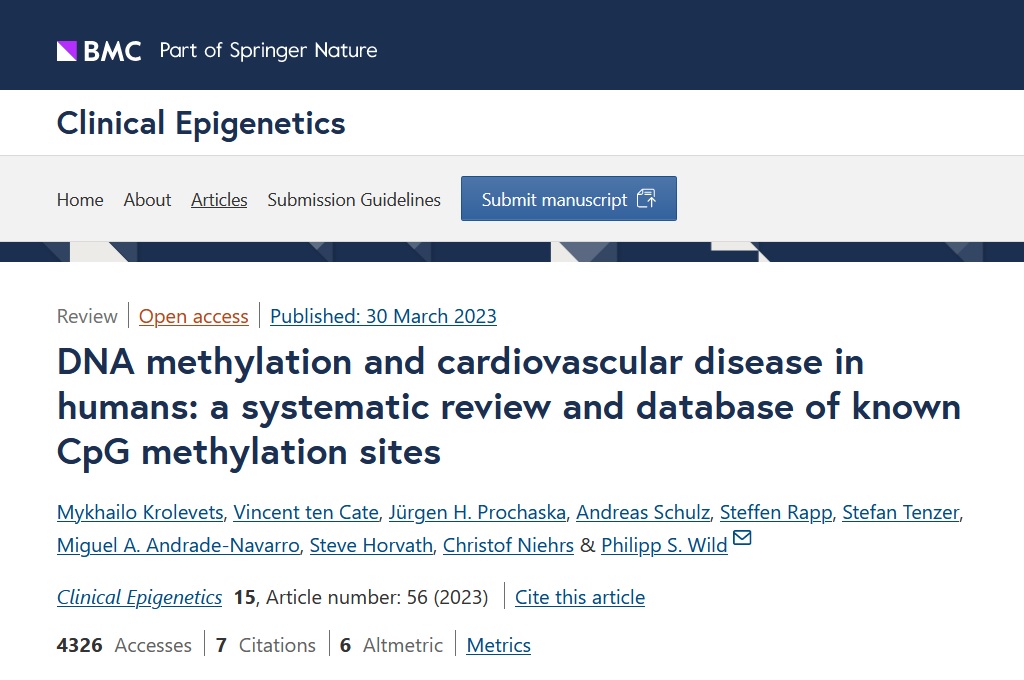Reference
Krolevets, M., Cate, V.t., Prochaska, J.H. et al. DNA methylation and cardiovascular disease in humans: a systematic review and database of known CpG methylation sites. Clin Epigenet 15, 56 (2023).
The relationship between DNA methylation and cardiovascular disease
Cardiovascular disease (CVD) is the leading cause of death globally, accounting for approximately 30% of all deaths worldwide. This puts an enormous burden on health-care systems across the globe and has prompted clinicians and researchers to explore potential causes of this wide-spread disease.
The World Health Organization recognizes CVD as one of the most environmentally driven diseases with a comparatively small genetic component. It is likely that epigenetic changes mediate, at least in part, the environmental risk for developing or progressing CVD. One prominent factor that is thought to play a role is DNA methylation.
DNA methylation is an epigenetic mark that can modify gene expression. DNA methylation usually refers to the methylation of the fifth carbon of cytosine residues found through-out the genome. Methylation is most commonly observed at so-called CpG islands, which are long repeats of cytosine-guanine nucleotides.
As technologies to study genome-wide DNA methylation continue to develop, there is growing evidence that there is a strong link between DNA methylation and CVD. However, there is still little to no evidence of the directionality of this relationship, and clear findings on relevant CpG sites or genes have not yet emerged from the extensive research in this area.
The main aim of this systematic review was to synthesize results of studies that have investigated the relationship between DNA methylation and CVD. Based on these results, we highlighted pathways that may be involved in the development or progression of CVD through a mechanism that is associated with DNA methylation changes.
Abstract of reference
A systematic review of articles examining measurements of DNA cytosine methylation in CVD was conducted in accordance with PRISMA (preferred reporting items for systematic reviews and meta‑analyses) guidelines. The search yielded 5,563 articles from PubMed and CENTRAL databases.
From 99 studies with a total of 87,827 individuals eligible for analysis, a database was created combining all CpG‑, gene‑ and study‑related information. It contains 74,580 unique CpG sites, of which 1452 CpG sites were mentioned in ≥ 2, and 441 CpG sites in ≥ 3 publications.
Two sites were referenced in ≥ 6 publications: cg01656216 (near ZNF438) related to vascular disease and epigenetic age, and cg03636183 (near F2RL3) related to coronary heart disease, myocardial infarction, smoking and air pollution.
Total 5,807 genes were reported in ≥ 2 studies. Most frequently reported were TEAD1 (TEA Domain Transcription Factor 1) and PTPRN2 (Protein Tyrosine Phosphatase Receptor Type N2) in association with outcomes ranging from vascular to cardiac disease.
STRING analysis revealed significant protein–protein interactions between the products of the differentially methylated genes (p = 0.003) suggesting that dysregulation of the protein interaction network could contribute to CVD.
This review highlights the current state of knowledge on significant relationship between DNA methylation and CVD in humans. The reported CpG methylation sites, genes and pathways that may play an important role in this relationship.
03-01-2024 updated.

